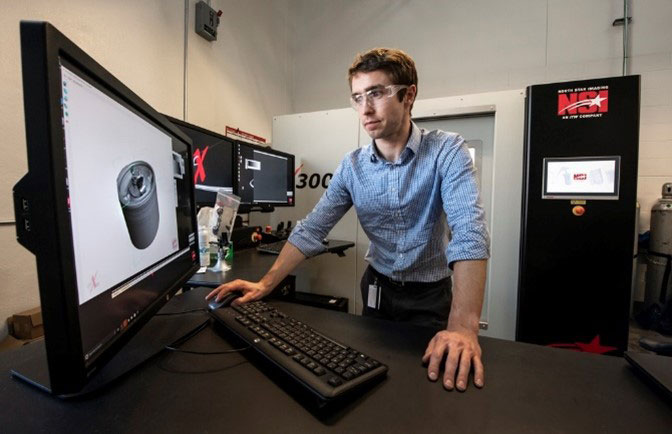X-Ray Diagnostics of Battery Materials
NLR researchers use state-of-the-art X-ray diagnostic capabilities as a nondestructive method to examine the composition and architecture of battery materials.

NLR engineer Donal Finegan uses X-ray computed tomography to diagnose Li-ion batteries. Photo by Dennis Schroeder, National Laboratory of the Rockies
The lithium-ion (Li-ion) batteries favored for energy storage in stationary applications, personal devices, and electric vehicles (EVs) are dynamic and systems of perpetually evolving composition and architectures. As Li-ion batteries degrade over time, numerous contributing factors cause unfavorable reactions and morphological transformation. To improve the energy density of batteries, extend their operating life, or make them safer, it is critical to understand how and why such dynamic processes occur and contribute to the performance and safety of batteries.
X-ray diagnostic techniques offer a way to examine properties of Li-ion battery materials, such as their crystal structure, chemical composition, and 3D architectures. Being nondestructive, X-rays can probe changes as they occur in real time without significantly interfering with the system. This provides a powerful tool for understanding the materials that we work with and guiding the design of next-generation Li-ion batteries.
Capabilities
NLR has a suite of advanced X-ray diagnostic capabilities, including X-ray computed tomography (CT), X-ray diffraction (XRD), X-ray fluorescence (XRF), and X-ray spectroscopy systems. Researchers at NLR have developed novel in-situ environments for this equipment to facilitate imaging during mechanical, electrochemical, or thermal changes within the material of interest. In addition, researchers established software tools to process, visualize, and quantify material properties for X-ray data including machine-learning segmentation methods and bespoke software packages for quantifying transport properties of porous materials.
Learn more about the energy storage facilities at NLR.
Advancements in Battery Research
Identifying the Optimal Architecture of Battery Electrodes
Using X-ray nano-CT, NLR built a comprehensive electrode microstructure library where researchers can compare calendared and uncalendered battery electrode samples that have or have not artificially generated conductive carbon and binder within the pore phase. Researchers around the world can use this databank to access realistic architectures for modeling or analysis.
Quantifying Limitations of Battery Electrodes During Fast Charging and Discharging
Researchers at NLR have used synchrotron XRD and XRD-CT to quantify gradients in lithiation and degradation throughout the depth of electrodes during fast charging and within individual electrode particles while they degrade. Applying world-leading synchrotron X-ray capabilities, this work creates new insights into the magnitude of chemical heterogeneities within battery electrodes during their lifetime and how such heterogeneities unfavorably affect the performance of batteries.
Understanding the Failure Mechanisms of Li-ion Batteries During Thermal Runaway
Thermal runaway of Li-ion batteries, during which batteries transform from intact to destroyed, occurs within seconds. Researchers at NLR used high-speed synchrotron X-ray radiography to understand the failure mechanisms of Li-ion batteries in a range of mechanical to thermal abuse scenarios. NLR has compiled an open-source Battery Failure Databank with hundreds of high-speed radiography videos of battery failure alongside their thermal responses during catastrophic failure. This data bank provides researchers and engineers around the world with insight to help guide the design of safer and battery systems.
Publications
For more publications related to battery development and energy storage systems, view the electrochemical energy storage publications.
Resolving the Discrepancy in Tortuosity Factor Estimation for Li-ion Battery Electrodes Through Micro-Macro Modeling and Experiment, Journal of The Electrochemical Society (2018)
Quantitative Microstructure Characterization of a NMC Electrode, ECS Transactions (2017)
Spatial Quantification of Dynamic Inter and Intra Particle Crystallographic Heterogeneities Within Lithium Ion Electrodes, Nature Communications (2020)
Spatial Dynamics of Lithiation and Lithium Plating During High-Rate Operation of Graphite Electrodes, Energy Environmental Science (2020)
Modelling and Experiments To Identify High-Risk Failure Scenarios for Testing the Safety of Lithium-Ion Cells, Journal of Power Sources (2019)
Contact
Share
Last Updated Dec. 6, 2025
